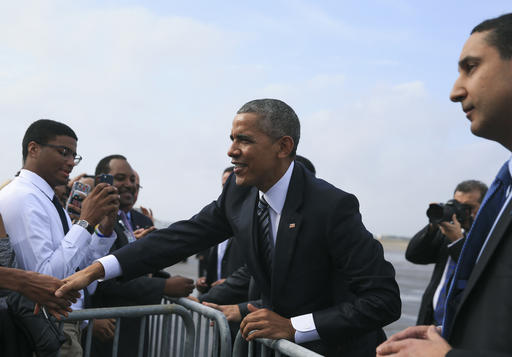TAMPA, Fla. (AP) — President Barack Obama vigorously defended a counterterrorism strategy that relies on special forces and local U.S. partners to minimize America’s military footprint, drawing a sharp contrast Tuesday to the more confrontational vision promoted by President-elect Donald Trump.
Obama’s speech at MacDill Air Force Base in Tampa, Florida, was to be his last major national security speech before he leaves office, the White House said. It comes as U.S. allies and foes alike are awaiting a potentially dramatic shift in U.S. strategy toward addressing extremist threats overseas after Trump takes office.
Before taking the stage for his speech, Obama met with top military leaders at the base, including Gen. Raymond Thomas, who heads U.S. Special Operations Command. He also told about 250 U.S. service members gathered in a gym that it had been the privilege of his lifetime to serve as their commander in chief.
“I have been consistently in awe of your performance and the way you carried out your missions,” Obama said.
For Obama, who came into office telling a war-weary nation he would wind down two wars and prevent new ones, the inclination toward smaller-scale, limited military involvement was a natural extension of his foreign policy philosophy. White House spokesman Josh Earnest said Obama had believed that large troop presences in Iraq and Afghanistan were unsustainable.
“The strategy that President Obama has put in place is more effective, it keeps us safe, it has fewer American men and women in harm’s way, and it costs American taxpayers a lot less,” Earnest said.
But Obama’s approach has most notably come up short in Syria, where Obama long ago predicted that U.S.-backed forces would eventually prevail over Syrian President Bashar Assad. But Assad’s grip on power appears stronger than it has in years while the brutal civil war continues to rage.
Trump has said little about how he intends to shift course in Syria and whether he would continue Obama’s strategy in other regions destabilized by extremist group. He’s argued that ambiguity and unpredictability are assets that deny the enemy a chance to plan ahead.
Still, all signs suggest he’ll pursue a more muscular, military-driven approach to extremist groups like the Islamic State in Syria and Iraq.
Trump has argued that Obama’s decision to withdraw the bulk of troops from Iraq, rather than negotiating harder with Baghdad to leave some there, created a power vacuum that allowed IS to form and seize territory.
During the presidential campaign, he said he would listen to top military officers about the need for ground troops to fight IS, at one point floating a figure of 20,000 to 30,000. Meanwhile, he’s suggested that ousting Assad isn’t a top priority and that closer alignment between the U.S. and Russia, which backs Assad, would be positive.
In the absence of more details from Trump, attention has turned to the advisers he’s selected to form his team, including retired Gen. Michael T. Flynn, tapped for national security adviser. Flynn, who has attracted controversy over his comments critical of Islam, has urged a far more aggressive military campaign against IS.
Obama was promoting Tuesday the benefits of his more limited approach. Under Obama, the number of U.S. troops Iraq and Afghanistan has dropped from roughly 180,000 to 15,000 today, according to deputy national security adviser Ben Rhodes said. Meanwhile, the U.S. has been able to take out key al-Qaida leaders, most notably Obama bin Laden, and has started edging the Islamic State group out of strongholds like Mosul in Iraq and Raqqa in Syria.
Yet while U.S. troop casualties declined significantly under Obama’s approach, as he finishes his term the U.S. is fighting in far more corners of the globe.
Military action under former President George W. Bush was mostly limited to Afghanistan, Iraq and Pakistan. Under Obama, the U.S. is also launching strikes in Syria, Somalia, Libya and Yemen, according to a report to Congress the White House released this week. Additional U.S. troops and assets are also in Jordan, Djibouti, Turkey, Egypt and Cameroon to support counterterrorism missions, while other overseas operations remain classified.
Much of the counterterrorism mission is being carried out not by traditional ground troops who have traditionally done most of the fighting in U.S. wars, but by commandos whose agility, advanced training and light footprint make them attractive for fighting in places where the U.S. doesn’t want to get bogged down. Among the units under the leadership of U.S. Special Operations Command, whose headquarters Obama was visiting Tuesday, are the Army Delta Force, Navy SEALs and the Army’s Green Berets.
Copyright 2016 The Associated Press. All rights reserved. This material may not be published, broadcast, rewritten or redistributed.







I just listened to the entire speech, and it was impressive. President Obama noted the advances US forces have made in the past eight years, and emphasized how our values inform our fight against terrorist extremism.
We have rejected torture, a reliance on large ground invasions which inevitably lead to large numbers of civilian casualties, and we have enlisted and partnered with nations in an effort to empower them to take an active role in defending their own countries.
This speech, while addressed to a group of service members, also had important lessons for our lawmakers in Congress and officials in the incoming administration, and I would say it was as inspiring as President Eisenhower’s farewell address.